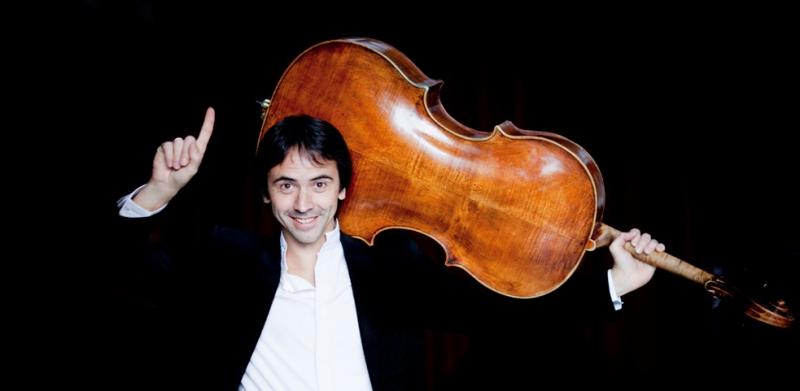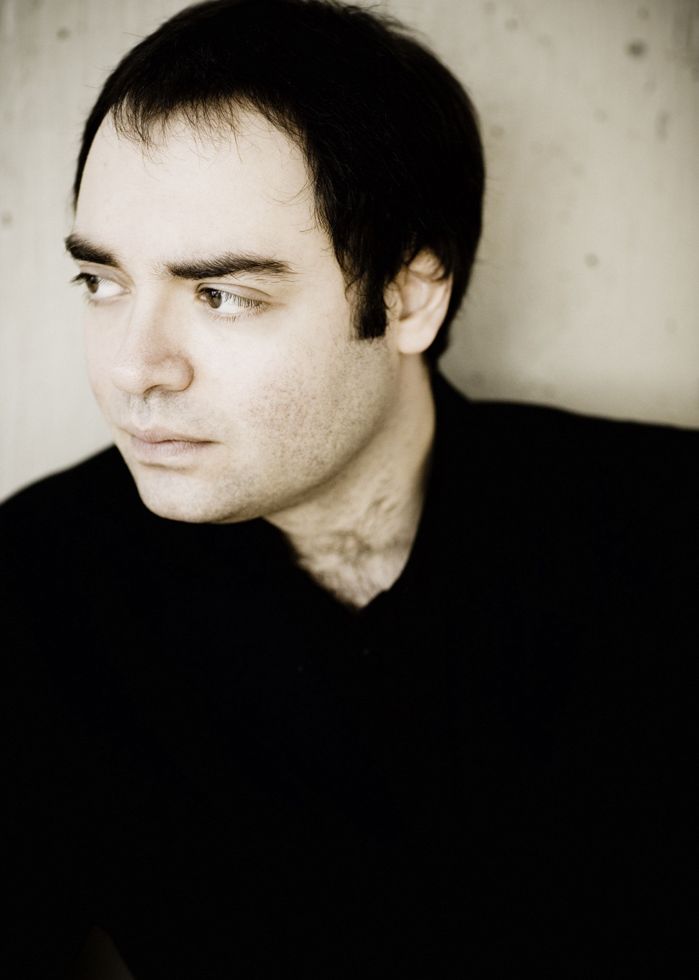Queyras, Melnikov, Wigmore Hall | reviews, news & interviews
Queyras, Melnikov, Wigmore Hall
Queyras, Melnikov, Wigmore Hall
First of two Beethoven recitals is mostly persuasive, even if the first half has only one gear

Even the most reluctant of completists should find the prospect of the Beethoven works for cello and piano undaunting. In their totality, these pieces consist of just five sonatas and three sets of variations, which fit neatly on to just two CDs, or occupy two recital programmes. The works are also very important in the early development of the solo cello repertoire.
French cellist Jean-Guihen Queyras and Russian-born pianist Alexander Melnikov (pictured below by Marco Borggreve) are performing these works over two nights, of which their Sunday Wigmore recital, played to a two-thirds-full house, was the first. It presented the first three sonatas and the last set of variations, with the last two sonatas and the first two sets of variations to follow on Monday.
Melnikov's judgements of how to create stillness and repose were completely persuasive
Queyras and Melnikov come from very different traditions indeed – one could easily imagine that Melnikov must have worked with Russian cellists with a massive concept of the tone of the instrument, whereas from his very first utterance in the F major Sonata from 1796, Queyras showed what an ethereal half-tone the instrument can produce. Despite their contrasting heritages, pianist and cellist have functioned as a regular duo for years, and form a partnership of equals. The detailed work that they have put into these Beethoven pieces was evident.
They were at their most eloquent in their judgment of pacing at the moments of near-stasis which precede the headlong launch into a rondo movement. These sections didn't feel calculated or forced, they simply felt right. Melnikov's judgements of how to create stillness and repose in the certain knowledge that the calm he is creating is about to be shattered were completely persuasive.
Those moments were very welcome in this programme, however, because the predominant mode of expression was very fast. There is no doubting both players' technical ability to dispatch these movements at speed, but the Op 5 sonatas are essentially made up of four quick movements at more or less the same tempo, in which a slightly lower gear would occasionally have been welcome. Or perhaps the overriding objective of presenting the complete works and the construction of a satisfyingly varied programme will always be at loggerheads with each other.
 Such quibbles were soon forgotten, because the most persuasive moments came in the second half. The first movement of the Third Sonata, Op 69, has exactly the same phrase ushering an almost infinite variety of different moods. Queyras's perfectly in-tune non-vibrato tone was particularly effective here. He is a classy player, who uses his wide tonal and expressive range to serve the music.
Such quibbles were soon forgotten, because the most persuasive moments came in the second half. The first movement of the Third Sonata, Op 69, has exactly the same phrase ushering an almost infinite variety of different moods. Queyras's perfectly in-tune non-vibrato tone was particularly effective here. He is a classy player, who uses his wide tonal and expressive range to serve the music.
And better still was the encore, the Largo of Chopin's Cello Sonata. It brought a reading that was exactly the dolce e cantabile prescribed, played by the cellist with clear understanding of and involvement in the harmonic progression. That was sheer delight.
- Second concert at the Wigmore Hall tonight
- Both concerts broadcast on BBC Radio 3 and available on the iPlayer for one month
rating
Share this article
The future of Arts Journalism
You can stop theartsdesk.com closing!
We urgently need financing to survive. Our fundraising drive has thus far raised £49,000 but we need to reach £100,000 or we will be forced to close. Please contribute here: https://gofund.me/c3f6033d
And if you can forward this information to anyone who might assist, we’d be grateful.

Subscribe to theartsdesk.com
Thank you for continuing to read our work on theartsdesk.com. For unlimited access to every article in its entirety, including our archive of more than 15,000 pieces, we're asking for £5 per month or £40 per year. We feel it's a very good deal, and hope you do too.
To take a subscription now simply click here.
And if you're looking for that extra gift for a friend or family member, why not treat them to a theartsdesk.com gift subscription?
more Classical music
 Robin Holloway: Music's Odyssey review - lessons in composition
Broad and idiosyncratic survey of classical music is insightful but slightly indigestible
Robin Holloway: Music's Odyssey review - lessons in composition
Broad and idiosyncratic survey of classical music is insightful but slightly indigestible
 Classical CDs: Wolf-pelts, clowns and social realism
British ballet scores, 19th century cello works and contemporary piano etudes
Classical CDs: Wolf-pelts, clowns and social realism
British ballet scores, 19th century cello works and contemporary piano etudes
 Bizet in 150th anniversary year: rich and rare French offerings from Palazzetto Bru Zane
Specialists in French romantic music unveil a treasure trove both live and on disc
Bizet in 150th anniversary year: rich and rare French offerings from Palazzetto Bru Zane
Specialists in French romantic music unveil a treasure trove both live and on disc
 Scottish Chamber Orchestra, Ibragimova, Queen’s Hall, Edinburgh review - rarities, novelties and drumrolls
A pity the SCO didn't pick a better showcase for a shining guest artist
Scottish Chamber Orchestra, Ibragimova, Queen’s Hall, Edinburgh review - rarities, novelties and drumrolls
A pity the SCO didn't pick a better showcase for a shining guest artist
 Kilsby, Parkes, Sinfonia of London, Wilson, Barbican review - string things zing and sing in expert hands
British masterpieces for strings plus other-worldly tenor and horn - and a muscular rarity
Kilsby, Parkes, Sinfonia of London, Wilson, Barbican review - string things zing and sing in expert hands
British masterpieces for strings plus other-worldly tenor and horn - and a muscular rarity
 From Historical to Hip-Hop, Classically Black Music Festival, Kings Place review - a cluster of impressive stars for the future
From quasi-Mozartian elegance to the gritty humour of a kitchen inspection
From Historical to Hip-Hop, Classically Black Music Festival, Kings Place review - a cluster of impressive stars for the future
From quasi-Mozartian elegance to the gritty humour of a kitchen inspection
 Shibe, LSO, Adès, Barbican review - gaudy and glorious new music alongside serene Sibelius
Adès’s passion makes persuasive case for the music he loves, both new and old
Shibe, LSO, Adès, Barbican review - gaudy and glorious new music alongside serene Sibelius
Adès’s passion makes persuasive case for the music he loves, both new and old
 Anja Mittermüller, Richard Fu, Wigmore Hall review - a glorious hall debut
The Austrian mezzo shines - at the age of 22
Anja Mittermüller, Richard Fu, Wigmore Hall review - a glorious hall debut
The Austrian mezzo shines - at the age of 22
 First Person: clarinettist Oliver Pashley on the new horizons of The Hermes Experiment's latest album
Compositions by members of this unusual quartet feature for the first time
First Person: clarinettist Oliver Pashley on the new horizons of The Hermes Experiment's latest album
Compositions by members of this unusual quartet feature for the first time
 Gesualdo Passione, Les Arts Florissants, Amala Dior Company, Barbican review - inspired collaboration excavates the music's humanity
At times it was like watching an anarchic religious procession
Gesualdo Passione, Les Arts Florissants, Amala Dior Company, Barbican review - inspired collaboration excavates the music's humanity
At times it was like watching an anarchic religious procession
 Classical CDs: Camels, concrete and cabaret
An influential American composer's 90th birthday box, plus British piano concertos and a father-and-son duo
Classical CDs: Camels, concrete and cabaret
An influential American composer's 90th birthday box, plus British piano concertos and a father-and-son duo
 Cockerham, Manchester Camerata, Sheen, Martin Harris Centre, Manchester review - re-enacting the dawn of modernism
Two UK premieres added to three miniatures from a seminal event of January 1914
Cockerham, Manchester Camerata, Sheen, Martin Harris Centre, Manchester review - re-enacting the dawn of modernism
Two UK premieres added to three miniatures from a seminal event of January 1914

Add comment